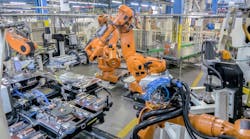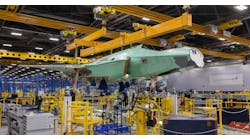North American manufacturers cut their acquisition of industrial robots by 30% in 2023, following two consecutive years (2021-22) of record purchasing activity. According to the Assn. of Advancing Automation, businesses purchased 31,159 robots during 2023, compared to 44,196 in 2022 and 39,708 in 2021.
“While robot sales naturally ebb and flow, the return to more typical robot sales after the last two record years can likely be attributed to a few obvious issues,” according to the trade group’s president, Jeff Burnstein. He listed a slow U.S. economy, higher interest rates and over-purchasing of robots during 2022, based on the “supply-chain concerns” that were so prominent at that time.
During 2023, new orders for industrial robots largely centered on the automotive sector: automotive OEMs and their suppliers purchased 15,723 robots, more than half of the total but still a -34% drop in sales to that industrial segment compared to the previous year.
“We’ve seen a slowdown in the manufacturing of electronic vehicles this year along with fewer new distribution centers, both likely reducing the demand for robots,” Burnstein observed. “From what we’re hearing in our member surveys and at recent events, however, optimism is strong for growth, potentially picking up in the second half of the year.”
Non-automotive manufacturers acquired 15,436 robots during 2023, which was a -25% total decrease sales to that sector versus the previous year.
The association reported that the sector with the strongest demand for robots during 2023 was metal-producing and -processing operations, followed by semiconductor and electronics/photonics; food and consumer goods; life sciences, pharmaceutical and biomedical; plastics and rubber, and others. Even so, each of these sectors displayed an overall decline in demand from 2022.
The final quarter of last year (October-December 2023) saw a 20% rise in robot sales from Q3, with higher sales of robots to automotive (OEM and components), metals, semiconductor and electronics/photonics, plastics and rubbers sectors, as well as the All Other Industries category. “All Other Industries” category includes construction, hospitality, and agriculture.
“While robotic sales were down over the year, 2023 ended with both an increase over the previous quarter and a nearly equal number of sales from automotive and non-automotive companies,” Burnstein said. “Both are promising signs that more industries are becoming increasingly comfortable with automation overall.
“While we expect to see automotive orders rise again, there’s little doubt that orders will increase from all non-automotive industries as they recognize how robots can help them overcome their unique challenges,” he said.






